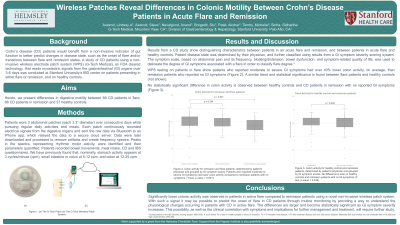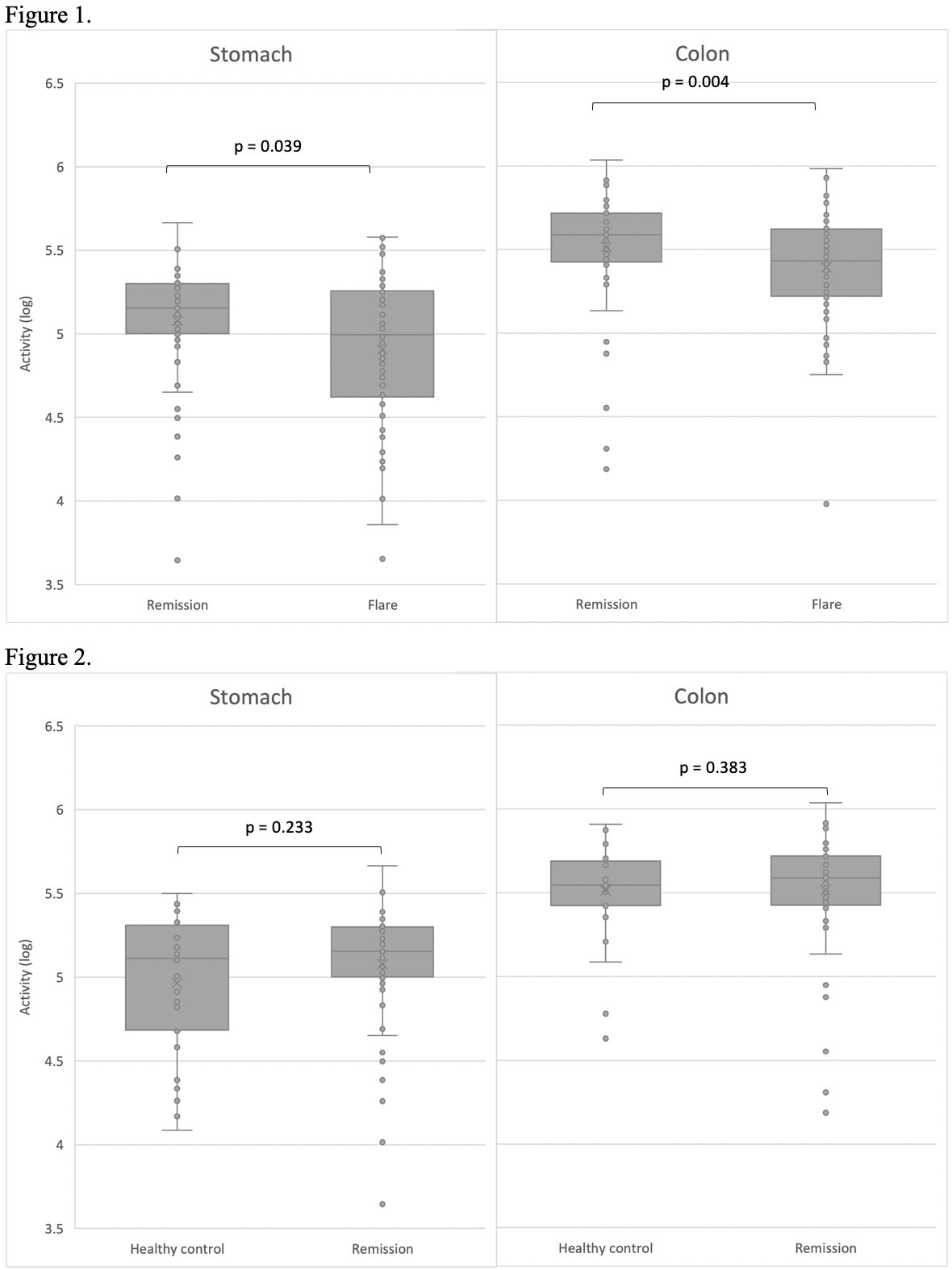Tuesday Poster Session
Category: IBD
P3565 - Wireless Patches Reveal Differences in Gastric and Colonic Motility Between Crohn's Disease Patients in Flare and Remission
Tuesday, October 24, 2023
10:30 AM - 4:00 PM PT
Location: Exhibit Hall

Has Audio
- LA
Lindsay Axelrod, MS
G-Tech Medical
San Mateo, CA
Presenting Author(s)
Award: Presidential Poster Award
Lindsay Axelrod, MS1, Steve Axelrod, PhD2, Anand Navalgund, PhD3, Akshar Patel, BS4, Stuart Brogadir, MD2, Sidhartha Sinha, MD4
1G-Tech Medical, San Mateo, CA; 2G-Tech Medical, Mountain View, CA; 3G-Tech Medical, Mountain View, CO; 4Stanford University, Palo Alto, CA
Introduction: Crohn’s disease (CD) patients would benefit from a non-invasive indicator of gut function to better predict changes in disease state, such as the onset of flare and/or transitions between flare and remission states. A study of CD patients using a non-invasive wireless electrode patch system (WPS) (G-Tech Medical), an FDA cleared technology, that reads myoelectric signals from the gastrointestinal (GI) organs over 3-6 days was conducted at Stanford University’s IBD center on patients presenting in either flare or remission, and on healthy controls.
Methods: Each patient wore 3 abdominal patches (each 2.7” diameter) for 3 consecutive days while pursuing regular daily activities and meals. Each patch continuously recorded myoelectric activity from the stomach, small intestine and colon, and sent the raw data via Bluetooth to an iPhone app, which relayed the data to a secure cloud server. Data were later downloaded and processed to remove artifacts, create frequency spectra, and searched for peaks representing rhythmic motor activity. We have previously found that, nominally, stomach activity appears at 3 cycles/minute (cpm), small intestine or colon at 5-12 cpm, and colon at 12-25 cpm.
Results: Early results from a CD study show distinguishing characteristics between patients in remission and acute flare. WPS testing on 66 remission and 66 flare patients, as determined by their physician, show active flare patients have significantly lower stomach and colon activity (Figure 1).
No statistical significance in the stomach or colon activity was found between remission patients and healthy controls (n=28) (Figure 2).
Discussion: Lower gastric and colonic activity was observed in CD patients in active flare compared to remission patients using a novel non-invasive wireless patch system. With such a signal it may be possible to predict the onset of flare in CD patients through routine monitoring. This possibility as well as the clinical correlation with symptoms and implications for further management and treatment, will require further study. The G-Tech WPS provides for a unique non-invasive way to understand the physiological changes occurring in patients with CD in active flare.

Disclosures:
Lindsay Axelrod, MS1, Steve Axelrod, PhD2, Anand Navalgund, PhD3, Akshar Patel, BS4, Stuart Brogadir, MD2, Sidhartha Sinha, MD4. P3565 - Wireless Patches Reveal Differences in Gastric and Colonic Motility Between Crohn's Disease Patients in Flare and Remission, ACG 2023 Annual Scientific Meeting Abstracts. Vancouver, BC, Canada: American College of Gastroenterology.
Lindsay Axelrod, MS1, Steve Axelrod, PhD2, Anand Navalgund, PhD3, Akshar Patel, BS4, Stuart Brogadir, MD2, Sidhartha Sinha, MD4
1G-Tech Medical, San Mateo, CA; 2G-Tech Medical, Mountain View, CA; 3G-Tech Medical, Mountain View, CO; 4Stanford University, Palo Alto, CA
Introduction: Crohn’s disease (CD) patients would benefit from a non-invasive indicator of gut function to better predict changes in disease state, such as the onset of flare and/or transitions between flare and remission states. A study of CD patients using a non-invasive wireless electrode patch system (WPS) (G-Tech Medical), an FDA cleared technology, that reads myoelectric signals from the gastrointestinal (GI) organs over 3-6 days was conducted at Stanford University’s IBD center on patients presenting in either flare or remission, and on healthy controls.
Methods: Each patient wore 3 abdominal patches (each 2.7” diameter) for 3 consecutive days while pursuing regular daily activities and meals. Each patch continuously recorded myoelectric activity from the stomach, small intestine and colon, and sent the raw data via Bluetooth to an iPhone app, which relayed the data to a secure cloud server. Data were later downloaded and processed to remove artifacts, create frequency spectra, and searched for peaks representing rhythmic motor activity. We have previously found that, nominally, stomach activity appears at 3 cycles/minute (cpm), small intestine or colon at 5-12 cpm, and colon at 12-25 cpm.
Results: Early results from a CD study show distinguishing characteristics between patients in remission and acute flare. WPS testing on 66 remission and 66 flare patients, as determined by their physician, show active flare patients have significantly lower stomach and colon activity (Figure 1).
No statistical significance in the stomach or colon activity was found between remission patients and healthy controls (n=28) (Figure 2).
Discussion: Lower gastric and colonic activity was observed in CD patients in active flare compared to remission patients using a novel non-invasive wireless patch system. With such a signal it may be possible to predict the onset of flare in CD patients through routine monitoring. This possibility as well as the clinical correlation with symptoms and implications for further management and treatment, will require further study. The G-Tech WPS provides for a unique non-invasive way to understand the physiological changes occurring in patients with CD in active flare.

Figure: Figure 1. Stomach (2.4-3.8cpm) and colon (12-18cpm) activity for Crohn’s remission and flare patients, determined by patient’s physician. Active flare patients have significantly lower average stomach and colon activity than remission patients. (T-test, p-value = 0.039 and 0.004 respectively).
Figure 2. Stomach (2.4-3.8cpm) and colon (12-18cpm) activity for Crohn’s remission patients and healthy controls, determined by patient’s physician. No statistical significance was observed. (T-test, p-value = 0.233 and 0.383 respectively).
Figure 2. Stomach (2.4-3.8cpm) and colon (12-18cpm) activity for Crohn’s remission patients and healthy controls, determined by patient’s physician. No statistical significance was observed. (T-test, p-value = 0.233 and 0.383 respectively).
Disclosures:
Lindsay Axelrod: G-Tech Medical – Employee.
Steve Axelrod: G-Tech Medical – Employee, Owner/Ownership Interest, Stock Options.
Anand Navalgund: G-Tech Medical – Employee, Stock Options.
Akshar Patel indicated no relevant financial relationships.
Stuart Brogadir: G-Tech Medical – Employee.
Sidhartha Sinha indicated no relevant financial relationships.
Lindsay Axelrod, MS1, Steve Axelrod, PhD2, Anand Navalgund, PhD3, Akshar Patel, BS4, Stuart Brogadir, MD2, Sidhartha Sinha, MD4. P3565 - Wireless Patches Reveal Differences in Gastric and Colonic Motility Between Crohn's Disease Patients in Flare and Remission, ACG 2023 Annual Scientific Meeting Abstracts. Vancouver, BC, Canada: American College of Gastroenterology.

